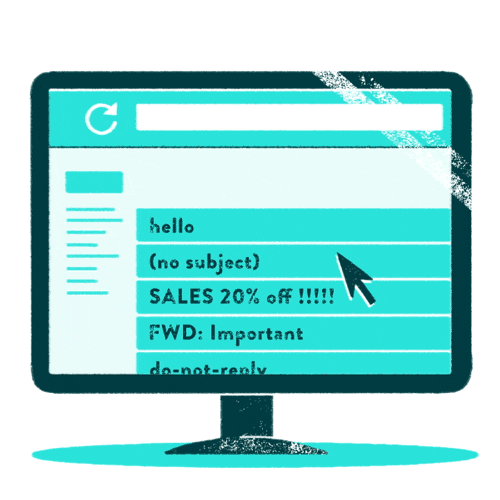Email Marketing
A Beginner’s Guide to Blocklisting

Email Marketing

This post was updated on May 9, 2019. It was originally published in January, 2012.
Blocklists run deep. They are not limited to filtering spam from email. A blocklist can take the form of a firewall restricting access from sources, a business (or, let’s be real, school) banning visits to X-rated websites, etc. The one thing all blocklists have in common is that they ban access from the sources explicitly listed. For our purposes, we’ll discuss blocklists as it relates to email.

An email blocklist is an ongoing database of known IPs (internet addresses) or domains whose emails have been flagged for spam or malicious content. An automated process or subscriber can land your domain on a blocklist. Various Internet Service Providers (ISPs) and email providers subscribe to blocklist databases in order to filter spam sent across their network to subscribers.
Internet organizations, such as MAPS, or Mail Abuse Prevention System, maintain lists of domains or IP addresses that are known in some way to support spammers’ activity. Sources that have open relays, host certain websites, distribute marketing spamming software, etc. are often included in blocklists. Mail servers, such as the one your inbox uses, are configured to automatically consult these blocklists when receiving an email. It searches the DNS for a specifically crafted format of the IP or domain address. This process will dictate if an email is going to hit the inbox or bounce back to the sender. For example, let’s say MAPS discovers there’s an open relay at the IP address 10.20.30.40. They make an entry designating abuse for 40.30.20.10.relays.mail-abuse.org in their DNS servers. The receiving mail server then looks up the sending mail server’s IP address when it receives the email. Then it does a nameserver (DNS) query for 40.30.20.10.relays.mail-abuse.org. If the receiving mail server confirms that the abuse entry exists in its database, then it throws an error back to the sending email client and refuses to accept the email. Alternately, if the mail server gets back an error due to no abuse entry record on the DNS server, the receiving mail server assumes the email originated from a safe source and proceeds to delivery. Here’s a simple chart from our friends at Spamhaus that illustrates this process:

Keep in mind that spam folders aren’t this black and white. Read up on email authentication protocols that can also affect email deliverability.
You can wind up on an email blocklist either by spam traps or subscribers. Spam traps are one of the most widely used fraud management tools by large domestic and international ISPs. They’re sometimes referred to as “honeypots” since their purpose is to lure spam emails. The three types of spam traps are recycled, pristine and typo.

Recycled spam traps are email addresses that were once owned by customers of the email provider who have stopped using their accounts. The ISP “gravestones” accounts after a predefined but undisclosed period of inactivity. It turns them off and returns hard bounces or SMTP errors to senders (ex: “550 – Unknown User”). After an email address has been gravestoned for 30 to 90 days, some will be reactivated, depending on the ISP. The addresses marked for reactivation are then recycled spam traps. Any email delivered to these accounts is recorded as a spam trap hit.

Pristine spam traps are email addresses that are created for the sole purpose of being a spam trap. These are unclaimed and unmonitored accounts that have no way to legitimately subscribe to an email list. Therefore, these accounts can only receive email as a result of list scraping or purchasing. This spam test has the largest impact on a brand’s reputation and its ability to deliver email to major ISPs. Again, this is due to email addresses being collected by unsavory tactics. Any email received at these email addresses is considered spam by the ISP or Anti-Spam Services.

Typo spam traps are email addresses that contain common typos, usually in the domain. For example, “james@gnail.com” instead of “gmail.com”. You can expect to find typo traps mostly on major email domains, like Yahoo!, Gmail, Hotmail, Outlook.com and AOL.
We know it hurts. The ones you love won’t always love you back. If a subscriber hasn’t heard from your brand in a while and doesn’t remember subscribing to your list, then they may mark as spam. Alternatively, if a subscriber feels inundated with emails from a brand but the unsubscribe button is hidden, then it’s easier to mark as spam. Check out our five tips for how to boost deliverability and avoid the potential for subscribers to mark you as spam.
There are ways you can get removed from a blocklist if you find yourself on one that vary from service to service. Most blocklist sites offer steps to removing your domain or any domain included in your message. For example, Spamhaus offers a “Blocklist Removal Center” where you can enter an IP address or domain and find information on how to get off the blocklist.
The key to avoiding blocklists is by avoiding spam traps and deploying consistent, strategic and intentional messages. Take an honest look at your email content and make sure you’re following email best practices. We sincerely recommend digesting this exhaustive list of spam-triggering keywords from our friends at Automational, but here are some very basic guidelines of what to avoid in general:
Most importantly, keep a healthy subscriber list. We hope this goes without saying by this point but never buy lists! Using a double opt-in method will spare you from most spam traps because no user will ever opt in from one of those email addresses.
The Spam Test feature of your Email on Acid workflow includes blocklist lookup of your domain against 72 of the most common blocklist services. Now that you know what a blocklist is, how domains can wind up on one and how to avoid them, you’re well-suited to face these head-on. Just remember to keep a healthy list and you’ll always get bonus points from us for double opt-ins.